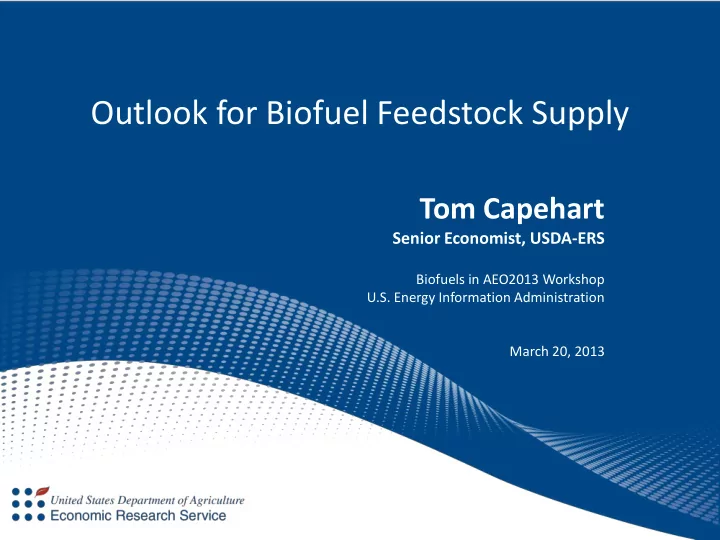

Outlook for Biofuel Feedstock Supply Tom Capehart Senior Economist, USDA-ERS Biofuels in AEO2013 Workshop U.S. Energy Information Administration March 20, 2013
Introduction • Ethanol is a Major Use for Corn • The U.S. corn market has been transformed by ethanol. • This season, projected corn for ethanol, accounts for 40.0% of the total use. • Feed and residual, historically the leading use for corn, is projected at 40.4%. • Current tight corn supply is expected to ease in coming years with increased corn production.
U.S. corn utilization Bil. bu 16 Feed and residual Exports 14 FSI less ethanol Ethanol Ending stocks 12 10 8 6 4 2 0 1985/86 88/89 91/92 94/95 97/98 2000/01 03/04 06/07 09/10 12/13 Source: USDA, World Agricultural Outlook Board, WASDE.
U.S. corn use for ethanol Mil. bu 6,000 5,000 4,000 3,000 2,000 1,000 0 1988/89 91/92 94/95 97/98 2000/01 03/04 06/07 09/10 12/13 Source: USDA, World Agricultural Outlook Board, WASDE.
U.S. corn prices reach record highs as stocks remain tight Mil. bu Dol./bu 2,500 8 Season average corn price 7 (right axis) 2,000 6 5 1,500 4 1,000 3 2 500 Corn ending stocks 1 (left axis) 0 0 1992/93 94/95 96/97 98/99 2000/01 02/03 04/05 06/07 08/09 10/11 12/13 Source: USDA, World Agricultural Outlook Board, WASDE.
What is the Baseline? • 10 year annual projections for agriculture – Long-term projections made in conjunction with Department’s budget baseline projections – Departmental annual long-term projections publication in February – Covers major U.S. and international agricultural markets • Projections, not forecasts – Conditional, long-run scenario – Neutral assumptions for macro, policy, weather • Prepared by USDA interagency committees – Composite of models & judgment-based analysis
Baseline Assumptions • Neutral assumptions – Normal weather – Agricultural policy • Continuation of current farm policies – Macroeconomic conditions • No business cycles
Baseline Coverage • Covers major agricultural commodities – Domestic markets • Supply, use, and prices – International markets and trade • Includes aggregate agricultural sector measures – Food prices – Farm income – Agricultural trade value
USDA Interagency Process • 12 interagency commodity committees – 4 to 5 agencies on each committee – Short-term projections, monthly – Long-term baseline projections, annually – Meetings to reach consensus projections – Chaired by the World Agricultural Outlook Board • Much interaction and flow of information between interagency committees – Consistency checks • Interagency baseline committee – 10 agencies – Coordinates baseline process – Assumptions, review, clearance
Baseline Projection for Corn Impacted by Ethanol Market • Ethanol production expansion to slow through 2023 – Reflects declining overall U.S. gasoline consumption • Most gas is 10% ethanol blend • Projection incorporates infrastructural and other growth constraints in the E15 market – E85 market is taken into account • About 35 % of total corn use expected to go to ethanol production through 2023.
U.S. corn: Feed and residual use, ethanol, and exports Billion bushels 7 Feed and residual use 6 5 Ethanol 4 3 2 Exports 1 0 1990 1995 2000 2005 2010 2015 2020 Source: USDA Agricultural Projections to 2022, February 2013.
U.S. corn use projections: Corn-based ethanol expansion slows Billion bushels 6 5 4 3 2 1 0 1990/91 1995/96 2000/01 2005/06 2010/11 2015/16 2020/21 Crop year Source: USDA Agricultural Projections to 2022 , February 2013.
Soybean Oil Baseline Projection • Soybean oil used to produce methyl esters (biodiesel) in the United States to grow 6.3 billion pounds by 2023 • Represents about 29% of total use of U.S. soybean oil • Forecast production of 800 million gallons of soy- based biodiesel by 2022 • Government mandates spur growth • 2013: 1.28 million gallons of biomass-based diesel • Renewable Fuel Standard’s advanced biofuel mandate (3.75 bil. gal in 2014, 21 bil. gal in 2022).
Soybean Oil Baseline Projection • Corn oil co-products from ethanol plants (including corn oil extracted from distillers grains), other first-use vegetable oils, animal fats, and recycled vegetable oils are also used as feedstocks to produce biodiesel • Growth in the food use of soybean oil slows as projected imports expand for other vegetable oils
U.S. soybean oil use projections: Million pounds 25 Total use 20 15 10 Biodiesel 5 0 2000/01 2005/06 2010/11 2015/16 2020/21 Crop year Source: USDA Agricultural Projections to 2022 , February 2013.
Summary • Return to normal corn yields will alleviate current tight supplies and ethanol production will rebound. • Declining gasoline consumption will slow future ethanol expansion. • Soy-based biodiesel production boosted by mandate. • Biodiesel will be used to meet advanced mandate.
Recommend
More recommend